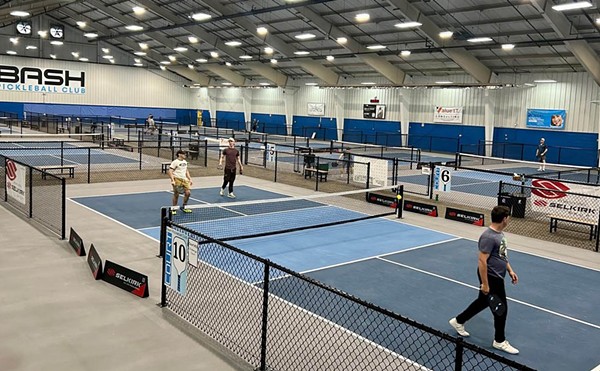When Antonio Cosme and William Lucka were arrested on Nov. 3, 2014, for allegedly painting "Free the Water" on a water tower in Detroit, few people would've guessed they wouldn't be formally charged until 16 months later.
On March 15, Cosme and Lucka were charged with the malicious destruction of property and trespass upon a key facility — both felonies. Their trial begins next month, and, if convicted, they face up to four years in prison, along with thousands of dollars in fines.
Lucka, 22, and Cosme, 27, are part of the Raiz Up, a hip-hop collective based in Southwest Detroit that pursues community-building through art, education, and direct action. They have vocally protested the Detroit water shutoffs and the injustices in Flint. Cosme and Lucka are immersed in a network that includes artists from the ONE Mile Project, activists from Black Lives Matter, the People's Water Board, the Detroit Eviction Defense, and more.
The wall of support that has formed around them since their arrest continues to grow. Led by members of the Raiz Up and the Detroit Eviction Defense, the Community Defense Committee started a crowdfunding campaign to raise money for the artists' legal fees.
Lucka has largely avoided talking to the media. Cosme, who agreed to speak to MT, was surprised by the amount of help they've received. "We've packed a courthouse, we've had fundraisers, we've gotten a lot of money online," he says. "There are people who want us to come speak at different events. I'll be going to Austria to speak at the University of Applied Arts Vienna ... There has been a lot of really amazing support that we've gotten in this short amount of time."
Cosme describes their case as "political theater."
"There are all these rape kits that go untested in the city of Detroit, yet there's money to chase graffiti artists," he says. Cosme's view of political theater is fundamental to what he calls "the new urbanism movement." He sees similarities among cities like Detroit, New Orleans, Washington D.C., and Baltimore.
"They wouldn't invest in Detroit and fix it up until black people lost control of it ... Detroit was starved for capital very intentionally."
The fall of Kwame Kilpatrick, Cosme believes, was the climax of a political drama meant to highlight the failure of the black electorate and the black political body as a whole. It signaled victory for people like Mayor Mike Duggan and Dan Gilbert, who Cosme situates at the forefront of a kind of neo-colonial "takeover" of the city.
"The consent agreement and the emergency manager is like a structural adjustment agreement," Cosme says. "They want to privatize resources and take away sovereignty from the citizens."
Robert Mullen, the artists' defense attorney, says the case of Cosme and Lucka is about more than just graffiti. "This is not about justice," he says. "I'm not saying that tagging property that you don't own isn't criminal in some sense, but this water tower case is not about crime; it's about politics."
Cosme and Lucka were charged with "specific-intent" crimes, meaning the prosecution must prove intent beyond a reasonable doubt. Mullen argues the prosecution will also be responsible for proving that they did not violate the defendants' constitutional right to a speedy trial.
One of the more interesting aspects of the case involves the water tower itself. The tower in question is located in Detroit, at 13512 Dequindre, but owned by Highland Park. The tower had been a part of Highland Park's municipal water treatment system, but as a Detroit News article indicates, this system went offline about two years before the artists' arrests, when Highland Park switched to the city of Detroit's water system. The switch, Mullen notes, was intended to be temporary, but remained in effect as of September 2015, nearly one year after the arrests.
During the trial, a number of questions will need to be addressed: Could the water tower be considered a working "reservoir" or "structure for the purpose of conveying water" at the time of defacement? If it was inactive, could it even be called a "key facility"? Did the artists injure the water tower "beyond repair"?
That this last question can even be asked reflects a particular view of what graffiti is capable of. In this instance, one might sensibly argue that the graffiti is a cosmetic concern, not an internal one. Even if the water tower were active at the time of the incident, the markings wouldn't have disrupted any interior mechanism.
When did defacement become synonymous with destruction, and why? Part of the answer may lie in how municipal governments understand and respond to the notion of blight.
According to the Oxford English Dictionary, "blight" is a word first introduced in 17th-century literature and, although its origin isn't certain, it may have been used by farmers or gardeners. Blight was defined as "any baleful influence of atmospheric or invisible origin, that suddenly blasts, nips, or destroys plants, affects them with disease, arrests their growth, or prevents their blossom from 'setting.'" In contemporary usage, blight indicates any harmful influence that "withers hopes or prospects, or checks prosperity."
When the city of Detroit announced its plan of adjustment to exit bankruptcy in late 2014, blight became an important talking point.
City of Detroit Corporation Counsel Melvin Hollowell tells MT that a court mandate called for "the eradication of blight and improving the overall quality of life for our neighborhoods."
Mayor Mike Duggan notably created a graffiti task force — a collaboration between Detroit administrators, prosecutors, and police forces — to make that happen. Since 2014, there have been dozens of successful prosecutions against graffiti artists, and thousands of unauthorized tags have been removed from properties.
Last year, the high-profile felony case against artist Shepard Fairey, who was accused of leaving unauthorized work on several buildings, was dismissed by a Wayne County Circuit judge. Fairey was commissioned by Gilbert's Bedrock Real Estate Services to create an 18-story mural on the side of One Campus Martius.
"In the past," Hollowell says, "blight was not contested. It takes on a number of areas in my office. For example, we will file and have filed cases on commercial blight, and that is when you have individual property owners who have kept their commercial properties in poor, deteriorating, and often dangerous conditions ... The second part deals with graffiti and other kinds of blight cases, and these are cases that did not get prosecuted before. The task force put together a more coherent approach."
The city's website explains that, if a property is found with graffiti on it, city inspectors will issue a notice to the manager or owner, who then must remove the graffiti within seven days. Those who fail to comply must pay a first offense fine of $130, and if the city ultimately removes the graffiti, an additional $200 cleaning fee must be paid.
The rigid enforcement of anti-graffiti law is not unique to Detroit. A study by professors at Portland State University entitled "Zero graffiti for a beautiful city: The cultural politics of urban space in San Francisco" revealed that municipalities in the United States spent an estimated $12 billion annually to get rid of graffiti circa 2009. In San Francisco alone, over $26 million in taxpayer money is used to support these initiatives every year. This amount doesn't include private expenses or legal costs for prosecuting graffiti-related crimes.
Zero-tolerance policies against blight were notorious in New York City in the '80s, when the controversial "broken windows" theory was introduced. The theory states that the appearance of neglect encourages the spread of criminal activity. Minor crimes like vandalism may eventually lead to more destructive crimes like arson. And so it is best to stop the minor criminals in their tracks, at all costs.
The ideology behind zero-tolerance elevates offensive or annoying crimes to grave ones. It interprets physical "disorder" as symptomatic of a disease whose hosts must be regulated and quarantined. When graffiti becomes a sickness that threatens the "quality of life," official policies against it seem soothing and apolitical. Property owners are happy to aid the city in their efforts while the gradual dissolution of public and private space goes mostly unquestioned.
Why is a city fresh out of bankruptcy paying its lawyers to prosecute two young artists who, according to their attorney, have no previous criminal records, who are accused of felonies and not misdemeanors, and possibly send them to prison for years?
"We've entered into a memorandum of understanding with the Wayne County Prosecutor's Office to handle charges under state law," Hollowell says. A significant amount of resources has been dedicated to cases related to graffiti and other crimes, including nine prosecutors at the 36th District Court led by the city's Chief of Criminal Enforcement and Quality of Life Doug Baker and Deputy Chief Megan Moslimani.
Ironically, the political significance of the tag Cosme and Lucka are accused of painting has been erased by the blindness of zero tolerance.
While the city of Detroit prepares to prosecute the artists, the artists themselves have other things in mind. One of Cosme's goals is to help Lucka launch his art career. He is also attending an organic farm school in Lansing so he can start a farm of his own next to his parents' old home, which was foreclosed in 2009.
Cosme says this is a moment not only to resist, but to generate.
"We can spend all our time resisting the crazy bullshit that's just gonna happen anyways," he says, "or we can start to educate our community and build in our community, create more conscious people who will have a chance of upending the existing paradigm later. It's just a change in strategy, in many ways."
The artists' trial is set to begin on Oct. 24 in Wayne County Circuit Court.
Aaron Robertson is a Detroit native and former Metro Times intern. He studies Italian literature as a senior at Princeton University, where he is editor-in-chief of The Nassau Literary Review.





